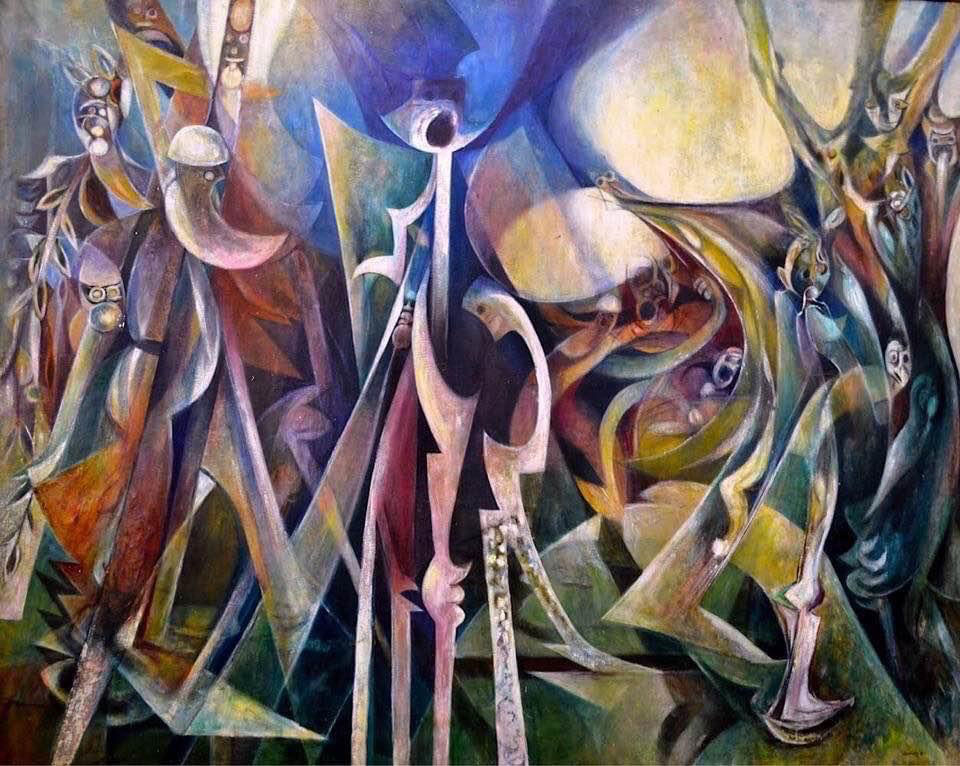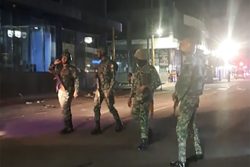 On Sunday, January 21 in the late afternoon, as Guyana approached the final cooling off of the day, artist Dudley Charles posed a simple question on a social media platform that stirred many: Where is this painting: Anansi Story? He followed these words with a brief indication of his efforts to ascertain its whereabouts and posted an image of the work. Dozens responded. And many shared his post. Eventually, an indication was made that it had never been lost. Anansi Story is still within the National Collection but it is no longer on display where it once was in the upper foyer of the National Cultural Centre. Therefore, it is no longer displayed where it is vulnerable to drinks, deliberate touch, and careless interaction.
On Sunday, January 21 in the late afternoon, as Guyana approached the final cooling off of the day, artist Dudley Charles posed a simple question on a social media platform that stirred many: Where is this painting: Anansi Story? He followed these words with a brief indication of his efforts to ascertain its whereabouts and posted an image of the work. Dozens responded. And many shared his post. Eventually, an indication was made that it had never been lost. Anansi Story is still within the National Collection but it is no longer on display where it once was in the upper foyer of the National Cultural Centre. Therefore, it is no longer displayed where it is vulnerable to drinks, deliberate touch, and careless interaction.
Now, some may think that the “official response” is as we call it, ‘Nancy Story.’ In the absence of the work not having been seen in years (and Charles has been asking about it for about two years) and in the context of works going missing from institutional collections, I imagine some have said, “Pish posh. Nonsense.” As one respondent to Charles’ post said before the announcement was made, “It is in someone’s house.” Far-fetched? No! Where is the inventory of works within the National Collection? At this point, we rely on artists’ testimonies and our memories of what we have seen there over the years to garner a sense of what is in that collection.
Where is the book that we can acquire for free or at a nominal cost that at the very least photographically documents the works in the National Collection with accompanying information like the name of the work (when known), artist (when known), etc? Panorama was an effort in this regard but after volume 1, the successive volumes have not materialised. Why not? Could it be because the book was being sold and the artists did not receive royalties? Questions were raised about the funds the project generated. And the questions were unanswered. Thus, the discussions at the time pointed to there being no clear articulation of ownership of the reproduction rights of works within the collection. This situation remains.
Nonetheless, the question of what we as Guyanese own is timely. We know our square kilometres and boundaries but what of this aspect of our cultural patrimony and heritage? Philip Moore was fond of recounting that he had over 400 works in the National Collection. His desire was for the works to be displayed together in what he called Moore’s Meditation Museum. His sculptures and paintings were acquired for the collection but a mere fraction of them has been shown to the Guyanese public, in small numbers at a time (roughly speaking twos and threes). The closest Moore came to seeing the fulfilment of his dream was in 2008. At that time the Museum of African Heritage hosted a special exhibition of Moore’s work which remained in his possession with loans of his work from private collections. The exhibition which was meant to be an Emancipation exhibition was also purposely mounted to share Moore’s vision with the visiting delegations of Carifesta. Moore’s work within the collection is a striking example of what we as Guyanese own that we do not even know we own.
What became of the inventory of the National Collection produced by Anton Rajer in the early 2000s? Then Rajer photographed works, wrote descriptions, and produced condition reports. He, therefore, documented works within the National Collection that were acquired when it was a nascent idea, after its establishment, and since the identification of a building to house and display it. Thus, he had the opportunity to consider the condition of work that had been folded and incorrectly varnished, etc when under the care of well-intentioned individuals who were not trained in collections management. Some works were worked on by Rajer and a team but many remained in need of urgent restoration. Thus, a well-prepared inventory allows for more effective care of the collection. However, at the very least in this technologically driven age, a list of works with thumbnail images should be found on a functioning National Gallery of Art (NGA) website, home of the National Collection. While simple, a list allows for new acquisitions to be added with ease. But, does NGA have a website? Unfortunately, this problem of inventorying and dissemination is not exclusive to the NGA. It is replicated with other institutional collections. Thus, artists are working and producing within a context of ‘don’t care-ness’ and disregard for their contribution to the cultural tapestry of our land.
Is inventory the only pressing problem for the National Collection? No! As much as we may love the architecture of our current space, Castellani House is not an ideal space for the NGA. It is too small considering the size of the collection. As a consequence, work from within the collection continues to be displayed in government offices where they cannot benefit from optimal care and equal access from the viewing public. In such a circumstance, unless complete up-to-date records are kept, with measures for accountability, work will go missing. Thus, Charles’ anxiety is justified after months of queries that had not been responded to.
Over the years Charles’ Old House images and River Spirit have repeatedly graced the walls of Castellani House but the work he sought information on has not. Why not? When it was eventually rescued from the corner where it was hung, was it because it was damaged? Has it since been damaged? Rotating with regularity the works that are shown allows more work to be seen and can hopefully quell fears about the inadequate management of the collection. Rotating the works also allows those who are charged with its care to identify problems as they emerge whether due to the circumstances of storage or as a consequence of peculiarities with the work despite adequate conditions of storage.
I share the following extract from a presentation I made at the Moray House Trust in January 2018:
Sometime in the first half of 1980, there was a political meeting at the Merriman Mall. Walter Rodney was scheduled to speak. Dudley Charles was there, but he stood on Church Street to watch the proceedings. He says he knew something was going to happen – “in those days something was always happening.” So, he had taken the viewing point he had. Rodney was scheduled to speak but was not allowed to speak with any instruments so he stood on a tapir with something like a bullhorn, Charles recalls. Police came with gas masks and tear-gassed the gathering.
In Anancy Story we can see Rodney to the front, with Eusi Kwayana to his left. We can discern the police with their batons, and gas masks to the left and the tear-gassed audience to the right of the composition on retreat and in horrific agony.
Was Charles intending to make a political painting? To say something deliberate about the Burnham government? “No,” he says. But he was trying to speak about the now and not yesterday, not a cultural past or a sanitised present with kokers and palm trees like many others were. In his estimation, “Art is the only true statement and vision of a nation,” so he needed to tell the stories of today for tomorrow. This is what he was doing with the Old House series and here with the Anancy stories.
——
I am happy Charles raised the alarm about this particular image. Hopefully, the full “official” response will be to put the work on show alongside all other work by Charles so audiences can discern from his visual texts as he may have intended. Hiding the work away is tantamount to silencing the artist and in these trying global times when artists are being silenced for acts of solidarity with victims of atrocities and are speaking from lived experiences of an ongoing apartheid, we cannot afford to seem to silence artists.










